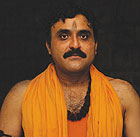|
USING A MACE |

|
|
Yogi Ashwini
|
Ancient Indians exceeded in understanding the energies and instruments which run this creation more than any other race in the world at a time when the world was supposed to be inhabited by barbarians and nomads. One of the manifestations of those energies is represented by the mace, popularly known in India as “gada”.
The mace existed since Vedic times and finds mention in ancient literatures signifying concentration of immense power and is associated with certain very powerful energies like Lord Hanuman, Bheemsen and many more who were carriers of the extremely powerful pranic force. It is more popularly associated with Hindu religion, but actually it has existed from a time where no religion existed, the vedic times. An eminent personality and a popular wrestler Gama Pahalwan was a Muslim and a practitioner of gada, which busts the myth of its association with Hindu religion.
The mace represents concentrated prana. Like earth moves around sun and gathers life force from it and stores it, similarly mace also moves around the body to gather life force to be used by its practitioner.
It has a shape similar to earth, and in the fashion that earth revolves around sun and rotates on its axis, mace movements are also practiced in double rotations to produce phenomenal power. It is not to be understood like an exercise routine, as it requires invocation of certain energies to awaken the hidden potential in the practitioner. Technical mastery of the ancients is revealed in gada’s architecture — the shape of the ball is like that of the earth, with the weight of the ball equivalent to that of the handle. In the beginning when a practitioner has just started to learn the basic movements, the weight recommended is 4 kgs:4 kgs, that of the ball and the handle. At this stage only a glimpse of the energy world are given to the beginner. As the sadhana progresses, invocations and mantras are introduced, the weight increases to 6:6, then 8:8 and 10:10.
Accomplished masters practice with 15:15 kilos (total of 30 kilos) of weight, after gaining mastery over the physical and etheric manifestations of the gada.
A very important pre-requisite for the practice of mace is a strong back and clean flow of prana in pranamaya kosha, specially sushumna nadi which can be achieved with the practice of Sanatan Kriya, and specific yogic techniques.
The spine should be in excellent condition as it is the primary support in carrying the body’s weight and aiding specific movements. It should be strong enough to hold 80-100 kilos of weight without any strain. Some specific mantras are chanted before and during the practice which harness the energy produced during the circular movements. The channels (nadis) in the etheric body need to be cleansed regularly to be able to allow the energy produced to flow through them and then to be stored in the manipoorak chakra, the centre of power in the etheric body.
The sadhana also requires one to practice samyam kriya where one chooses an energy force like sun, moon or fire, as prescribed by the guru and calls for their force to be channelised in the physical and subtle body.
A practitioner of mace is endowed with immense physical strength, virility and radiance like the sun and the physical body becomes a reflection of the form of one’s guru.
The movement of energy in subtle channels increases sukra (the vital fluid and potency in the body) and provides unsurpassed strength visible in the radiance and beautiful shape the body of the practitioner exhibits. An immediate state of balance in pranamaya (subtle body) and annamaya koshas (physical body) is achieved in the initial stages which gets more and more enhanced as the practice progresses. The ultimate state is the reflection of the energy focused on the self, as what yoga teaches, what you follow, so as you become. No yogic practice is complete or accomplished without guru’s grace and any doubt on the guru results in failure of the practice, which then simply becomes a physical exercise.
|
|
|
|
—The writer Yogi Ashwini Ji is the
head of Dhyan Foundation, Delhi.
For Details contact: ashwiniyogi@yahoo.co.in
|
|
|
|
|
|
February 2011
|
|


|
|
|
|